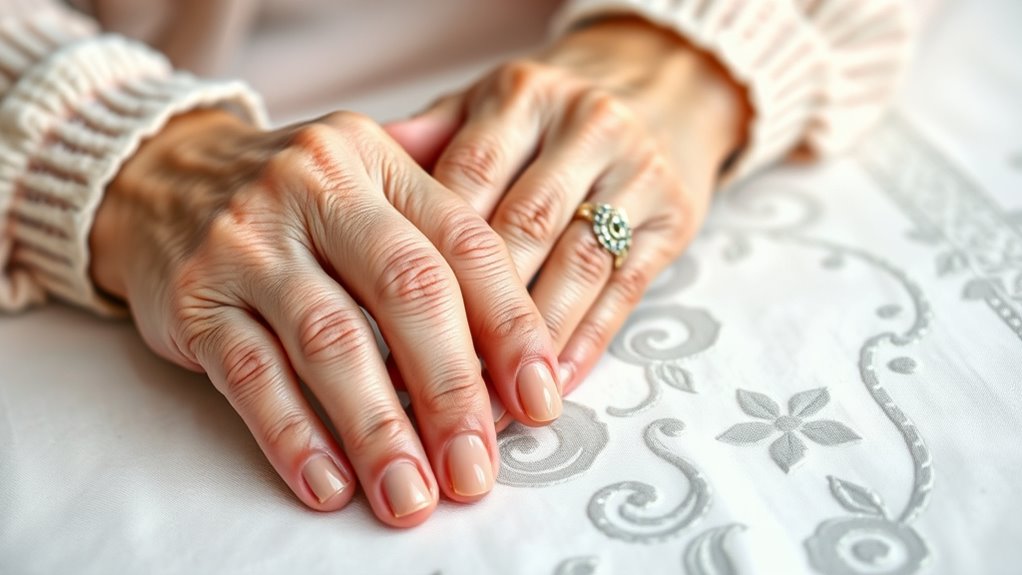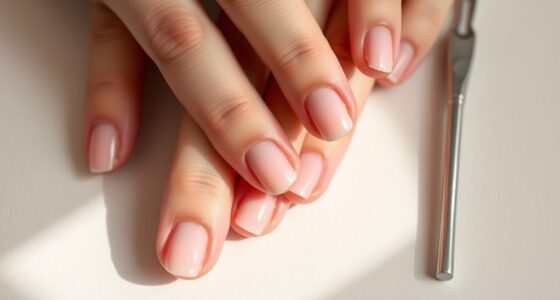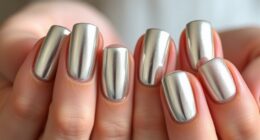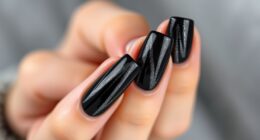As you age, updating your nail care routine helps keep your nails healthy and strong. Moisturize regularly with nourishing oils or creams to combat dryness and reduce cracking. Avoid harsh chemicals and excessive water exposure, and trim nails carefully to prevent splits. Incorporate a balanced diet rich in biotin, zinc, and vitamin E to support growth. By making these adjustments, you can maintain attractive nails—I’ll share more tips to keep your nails in great shape.
Key Takeaways
- Moisturize nails regularly with nourishing oils or creams to combat dryness and prevent cracking.
- Avoid harsh chemicals and excessive water exposure that weaken aging nails.
- Trim and file nails gently to prevent tears and maintain smooth edges.
- Incorporate a balanced diet rich in biotin, zinc, and vitamin E to support nail strength and growth.
- Monitor nail changes and seek medical attention for persistent issues like discoloration or pain.

As you age, maintaining healthy nails becomes increasingly important, yet it can also become more challenging. Many older adults face concerns about their nail health, often influenced by common nail health myths that circulate. These myths can lead you to believe that nail deterioration is an unavoidable part of aging, but that’s not entirely true. Understanding the aging nail structure helps clarify what changes are normal and what might need attention. As you grow older, your nails may become thinner, more brittle, or develop ridges, but these changes don’t necessarily mean you’re neglecting your health. Instead, they are often a natural part of the aging process, caused by slowed cell turnover and decreased moisture retention in the nail matrix.
It’s essential to dispel nail health myths that suggest aging automatically leads to poor nail quality. For example, some believe that nail fungus is an inevitable consequence of aging, but this isn’t accurate. While older adults are more susceptible to fungal infections due to a weakened immune system and drier skin, good hygiene and proper nail care can markedly reduce this risk. Another myth is that nails stop growing altogether as you age; in reality, nail growth slows down but doesn’t cease. Understanding your aging nail structure reveals that the bed and matrix may become less resilient, making nails more prone to splitting and breaking. Additionally, maintaining good circulation through hydrotherapy can help improve nail health by promoting better blood flow to the nail beds.
To support healthy nails, you should adapt your care routine. Focus on keeping nails moisturized, especially since aging skin and nails tend to lose hydration. Using a nourishing cuticle oil or hand cream regularly can help prevent dryness and cracking. Avoid harsh chemicals and excessive exposure to water, which can weaken nails further. When trimming nails, do so carefully to avoid causing tears or splits, and consider filing gently to smooth edges instead of aggressive buffing. Incorporate a diet rich in vitamins, particularly biotin, zinc, and vitamin E, which promote nail strength and growth.
Pay close attention to any persistent changes, like severe ridges, discoloration, or pain, as these may indicate underlying health issues that require medical attention. Regularly inspecting your nails and maintaining good hygiene can prevent many common problems. Remember, aging doesn’t have to mean giving up on healthy, attractive nails; with proper care and awareness of your unique aging nail structure, you can continue to enjoy strong, beautiful nails well into your senior years.
Frequently Asked Questions
How Often Should Seniors Trim Their Nails for Optimal Health?
You should trim your nails regularly, ideally every one to two weeks, depending on your nail growth rate. Maintaining a consistent nail grooming schedule helps prevent issues like ingrown nails or infections. Pay attention to your nails’ appearance and feel, trimming when they become too long or uneven. Regular nail trimming frequency guarantees your nails stay healthy, comfortable, and less prone to damage, supporting overall nail health as you age.
Are There Specific Vitamins That Improve Senior Nail Health?
Imagine your nails as tiny shields, shining brightly when nourished. You might boost your nail health with specific vitamins like biotin, vitamin E, and zinc to combat deficiencies. Nutritional supplements can fill gaps in your diet, promoting stronger, healthier nails. Consult your healthcare provider to identify any deficiencies and determine the right supplements, helping you maintain those resilient, beautiful nails as you age gracefully.
Can Certain Medications Affect Nail Strength in Seniors?
Certain medications can impact your nail strength by causing medication interactions that lead to nail thinning. You might notice your nails become more fragile or brittle after starting new prescriptions. It’s important to check with your healthcare provider about potential side effects, including how your medications could affect your nails. They can suggest alternatives or additional care strategies to help maintain healthy, strong nails despite medication use.
What Are Signs of Nail Infections in Elderly Individuals?
Nail infections can be like uninvited weeds in your garden, showing signs you shouldn’t ignore. Watch for nail discoloration, which may turn nails yellow, green, or brown. Fungal growth causes thickened, brittle nails that crack easily. You might also notice a foul odor or pain around the nail bed. Catching these signs early helps prevent the infection from spreading, so keep an eye on your nails and seek treatment promptly.
How Can Seniors Prevent Nail Damage From Daily Activities?
To prevent nail damage from daily activities, focus on good nail hygiene by keeping your nails clean and dry. Wear protective gloves when doing chores or using harsh chemicals, and avoid biting or picking at your nails. Regularly moisturize your cuticles to prevent cracking, and trim your nails carefully. These daily protection habits help maintain healthy nails and reduce the risk of damage or infection as you age.
Conclusion
Think of your nails as the sturdy roots of a tree, anchoring you through life’s seasons. As you age, tending to this foundation keeps your tree strong and vibrant. With gentle care and mindful routines, you nurture your nails just like nourishing the soil around roots. Embrace these simple changes, and watch your nails flourish, supporting your journey with resilience and grace. Your care today helps keep your natural strength thriving for years to come.









